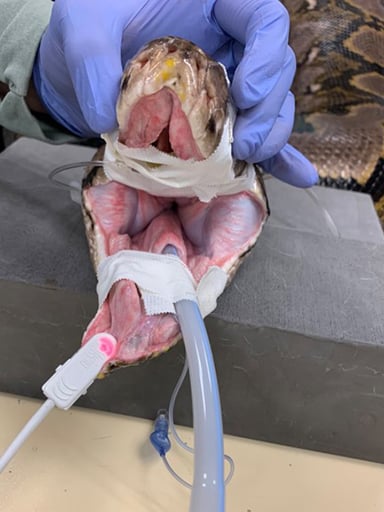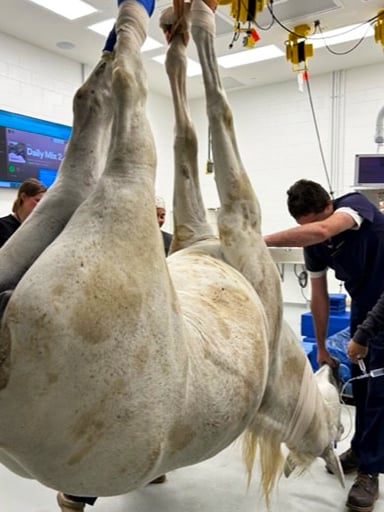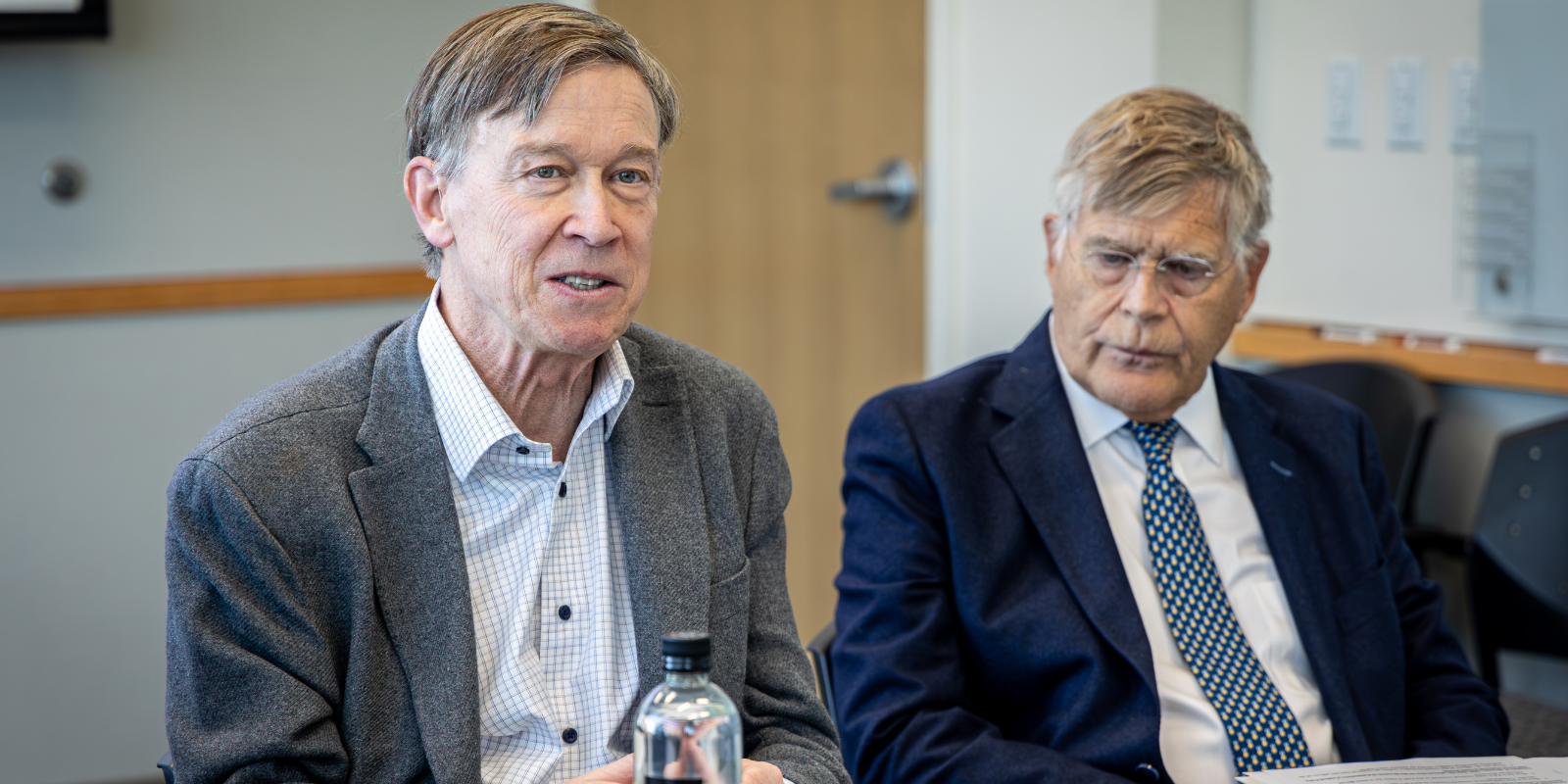As a cardiothoracic anesthesiology fellow, Rizwan Nazarali, MD, keeps people safely asleep through major, open-chest surgeries. He monitors cardiopulmonary bypass when surgery patients’ hearts or lungs are outside of their bodies, and he manages patients on ECMO, a machine that keeps them alive while they wait for heart or lung transplants.
But give him a goat, a horse, or a dog, and even his rigorous training isn’t always enough.
“With humans, for the most part, you can communicate with them,” Nazarali said. “You can tell them what you want. They are lying on a bed, and you put them to sleep,” he said, noting that it also helps that they are all one species. “But animals, they are a completely different beast.”

An intubated snake is prepped for its procedure. |
Thanks to a novel elective program recently launched by two anesthesiology faculty members – one in the University of Colorado School of Medicine at the CU Anschutz Medical Campus and one in the College of Veterinary Medicine and Biomedical Sciences at Colorado State University – Nazarali last year learned some tricks of the animal medicine trade.
Then a fourth-year resident in the CU Department of Anesthesiology, Nazarali said he found the intense week working at the teaching hospital of the nation’s No. 2 veterinary school an “eye-opening” experience that gave him a greater appreciation of the diversity of physiology in mammals and broadened his skills.
Species diversity fuels creative thinking
“Because we have the species diversity, it provides the participating CU residents an opportunity to see a different breadth of practice,” said CSU Professor Khursheed Mama, DVM. “It teaches them how to apply what they know about human patients in a wider environment.”
“With their expertise and high level of training in similar procedures, physician anesthesiology residents under direct supervision are able to observe and participate in a variety of anesthetic techniques,” said CU SOM Associate Professor Angela Selzer, MD, who launched the exchange program with Mama.
From nerve blocks and intubations to catheter placements and anesthetic administration, CU residents gain experience working on a variety of animals, all while under the guidance of veterinary anesthesiologists ensuring quality patient care, Selzer said. And the residents often find themselves having to think outside the box.
“You have animals that don’t understand you, that can’t follow directions, that can’t tell you what’s going on, that have different physiology and anatomy,” Selzer said. “How do you trouble-shoot these scenarios in order to provide a safe anesthetic?”
One day, the CU residents might find themselves in a situation – maybe in a rural area, or on a cruise ship – where they are called to help and they don’t have all the things they are used to having in a hospital setting, Mama said. “Maybe this experience will help them adapt to unusual circumstances.”
The toughest patient? A horse, of course
At the busy CSU veterinary hospital in Fort Collins, anesthesiologists often are adapting between every patient, Nazarali said, using an experience treating a horse during his rotation as an example.
The horse needed an arthroscopy of its knee, a procedure that involves inserting a tiny diagnostic scope through a small incision and might require only a local anesthetic for a human. But for a horse, general anesthesia is required, a task that sounds easier said than done.

CSU's state-of-the-art veterinary teaching hospital is equipped to handle multiple scenarios with all of its animal patients. |
After leading the horse into a corner of a special room of padded walls and administering the medications, Nazarali and his veterinary peers leaned against the animal as it fell asleep, guiding it against the wall and down to the floor to prevent injury, he said.
Next up: Transporting a 1,200-pound animal to a procedure room. “Basically, you hobble them by their ‘ankles’ and lift them using a hoist to mechanically transport them to the operating room,” he said. “That was incredible – just the thought that goes behind something like that, right?”
A deeper look at their medication toolbox
Medications also are continually adapted in a multi-species setting, adding another dimension to the learning experience, Nazarali said.
“I deal with one species. Generally, I know that these drugs are going to work just as well for Mr. Joe as they do for Ms. Dolly. But in the span of four or five hours at CSU, you’re taking care of four or five different species, and what you used for species A is dramatically different for species B. So, yeah, it’s an adventure, and it’s challenging.”
The program creates well-rounded anesthesiologists, pushing them beyond their comfort zones and expertise, Selzer said. “Even if they are never going to administer a drug to a horse again in their lives, that experience will deepen their understanding of that medication, and that class of medications, in a way that you can only achieve with this type of experience.”
The quality of the medications used for the largely four-legged critters also surprised Nazarali. In addition to drugs commonly used in human medicine, medications found not suitable for humans due to adverse effects are sometimes used in animal patients, because they often do not have the same side-effect profile, he said.
“They use very modern drugs and anesthetics, and they can often get them at a lower cost due to market drivers,” said Nazarali, who was impressed with the animal hospital’s overall cost-conscious practices without affecting quality of care.
‘We are all in the same profession’
Although the CSU students, faculty and residents who visit CU Anschutz as part of the program cannot perform hands-on procedures on patients, they still enjoy their week of observing human anesthesiology, Mama said. “For our residents, it’s good to see what our colleagues in human medicine are doing in managing patients, how they approach problems and the types of cases they are doing.”
“With humans … you can communicate with them. You can tell them what you want. But animals, they are a completely different beast.” – Rizwan Nazarali, MD
Selzer asks CSU participants about research interests and pairs them with anesthesiologists who are working in similar areas, she said. She also tries to expose CSU participants to the breadth of care that anesthesiologists provide at CU Anschutz, rotating them between specialty areas, such as the chronic pain clinic, the intensive care unit, obstetrics, cardiac surgery and neurosurgery.
“Plus, it’s fun,” Mama said, which helps explain why participants on both sides have said the program reduced burnout, a real issue in both of the rigorous medical professions. “The intent was an educational exchange, but it’s also about building relationships, because we are all in the same profession,” she said. “Some of us work in human medicine, and some of us work in veterinary medicine, but we are all anesthesiologists.”
Photos at top: Rizwan Nazarali, MD, works on a goat, a horse and a dog during his rotation at CSU's veterinary teaching hospital.




